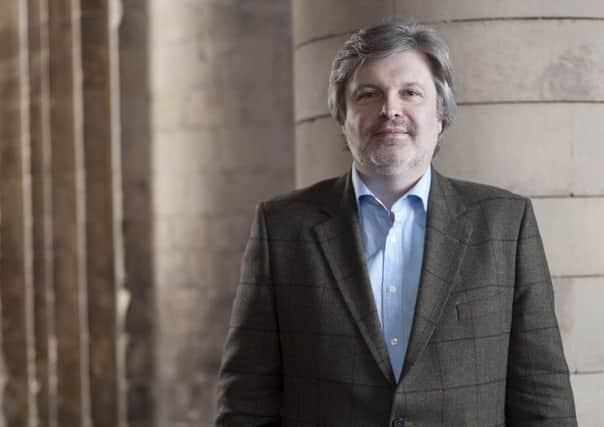Classical: Sir James MacMillan’s Symphony No.4


The 2015 BBC Proms kicked off with the usual pomp and celebration last night, and there’s a good deal of music from Scottish performers to come across the season’s mighty stretch of 92 concerts. Not least a half-cycle of Sibelius symphonies (well, the first four) across two concerts from the BBC Scottish Symphony Orchestra under its chief conductor designate Thomas Dausgaard (he completes the cycle with 5, 6 and 7 in Glasgow in October).
But it’s the BBC SSO’s current chief conductor, the redoubtable Donald Runnicles, about to enter his final season heading the orchestra, who’s the dedicatee of one of the Proms season’s most significant new commissions – the fourth symphony by the recently knighted Sir James MacMillan. “The idea came from the orchestra, and in particular from Donald,” MacMillan explains. “He’s conducted a lot of new music, and he wanted a new piece that might coincide with his tenure at the BBC SSO – so I’ve just managed to get it in.”
Advertisement
Hide AdThe new symphony is a transatlantic co-commission, bringing in other conductors who have supported MacMillan’s work – Manfred Honeck at the Pittsburgh Symphony and Joana Carneiro at the Berkeley Symphony in California, both of whom will conduct US performances in the coming months.
It’s been quite a few years since MacMillan’s previous symphony: No. 3 (Silence) dates from way back in 2002, and it came shortly after No. 2 (written for the Scottish Chamber Orchestra in 1999) and No. 1 (1997). So why a symphony? And why now?
“This is actually an orchestral piece that turned into a symphony,” MacMillan says. “I had the feeling that I wanted to write a big, abstract work, and it made sense for it to become a symphony.” It wasn’t long ago that avant-garde musicians were predicting the symphony’s demise, but that obviously hasn’t happened. “It’s clear that some symphonies written recently have very little to do with ones written in the past, but there are still lots of reasons why composers use the title ‘symphony’, MacMillan says. “I think it might have something to do with the sense of breadth that a work like this offers. It’s a big, abstract piece, in one movement, probably about half an hour long, and it seems to fit in with the general thrust that I think symphonies have.”
And despite the long gap, the idea of a symphony had never really gone away. “I’ve been thinking about the piece for years, actually, and it was only in 2014 that I managed to settle to it. I’d spent a long time trying to get a structure and trajectory in place, as well as certain types and characters in the music.”
He repeatedly uses the word “abstract” to define his new work, as if keen to stress that the symphony isn’t “about” anything. “It’s not really a conscious thing, but I think my music has become more abstract in recent years. That’s not to say that the idea of the descriptive tone poem has finished for me. But when it comes down to it, even my most representational pieces – such as The Confession of Isobel Gowdie, for example – have to stand on their own two feet as music that uses musical devices.”
Nevertheless, the new symphony has two distinct connections with the real, extra-musical world. The first is a sense of ritual, conveyed through what MacMillan calls four archetypes – of movement, exhortation, petition and joy – each symbolised as a contrasting musical idea. “Ritual has fascinated composers for centuries, whether it’s in opera or church music, even ballet, and because all our rituals usually have music associated with them,” he says. And connected with MacMillan’s idea of ritual is his second nod to the real world, in the form of quotations from the gloriously rich church choral music of Renaissance Scottish composer Robert Carver. “He’s been such a big figure in my adult life as a composer in Scotland, and I’ve always wanted to acknowledge some kind of debt. I love the austerity of his music, but also its complexity. I’ve incorporated some of his ideas into the structure of the symphony and wound my own music around it.”
Advertisement
Hide AdAnd he’s come up with a novel way of doing so, asking the players at the backs of the viola, cello and double bass sections to play the Carver fragments, as if muffled within the orchestral fabric.
Orchestral players have had a huge influence on the writing of the symphony – specifically those of the BBC SSO, whom MacMillan knows so well from their long association. “When I wrote the piece I had faces in mind rather than just instruments,” he explains. “There’s a particular trumpet idea, and I can see Mark O’Keeffe’s face, and when the cellos have their big moment towards the climax, I could see that whole cello section as I wrote it.”
Advertisement
Hide AdFollowing its performances in London and in the US, are there any hints of an outing north of the Border? “I do have an inkling of a Scottish performance,” says MacMillan. “It hasn’t quite been bedded down yet, but I think there might be one next year.” And despite the lengthy wait since MacMillan’s previous symphony, it looks like the Fourth’s successor might come hot on its heels. “Yes, there’s been a long gap between the Third Symphony and this one,” he says, “but there might not be such a long gap between the Fourth and the Fifth – maybe I’ve just got into my stride, but I can feel another work like this emerging reasonably soon.”
• Sir James MacMillan’s Symphony No. 4 is premiered on 3 August by the BBC Scottish Symphony Orchestra and Donald Runnicles, live on BBC Radio 3 and on BBC4 on 6 September www.bbc.co.uk/proms